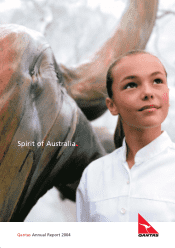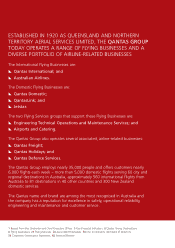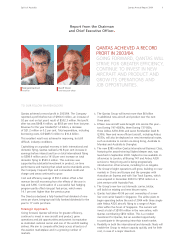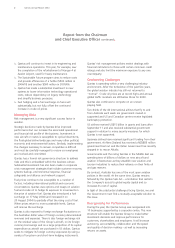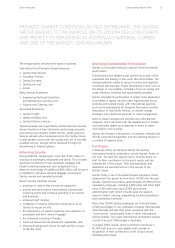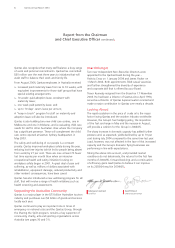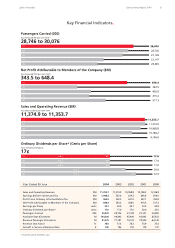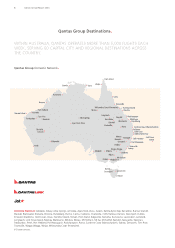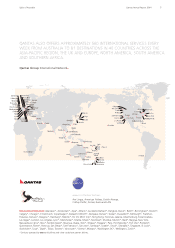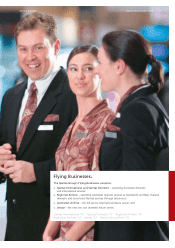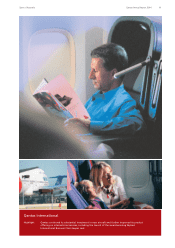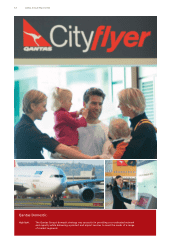Qantas 2004 Annual Report Download - page 4
Download and view the complete annual report
Please find page 4 of the 2004 Qantas annual report below. You can navigate through the pages in the report by either clicking on the pages listed below, or by using the keyword search tool below to find specific information within the annual report.
2Qantas Annual Report 2004
Qantas will continue to invest in its engineering and
maintenance operations. This year, for example, saw
the completion of the refurbishment of Hangar 4 at
Avalon Airport, used for heavy maintenance.
The Sustainable Future program aims to reduce costs
and provide efficiencies of a further $500 million in
2004/05 and another $500 million in 2005/06.
Qantas has made a substantial investment in new
systems to lower information technology operational
costs, reduce dependency on legacy technology
and simplify business processes.
Fuel hedging and a fuel surcharge on fares will
substantially, but not fully, offset the continued
increase in crude oil prices.
Managing Risks
Risk management is a very significant success factor in
aviation.
Strategic decisions made by Qantas drive improved
performance but can increase the associated operational
and financial risk profile of the business. Investment in
new aircraft or routes is susceptible to cyclical downturns,
the fluid global airline landscape and many other political,
economic and environmental factors. Similarly, implementing
the changes necessary to remain competitive is difficult
and must be carefully managed to ensure our employees
are involved and committed.
Qantas has a formal risk governance structure to address
risks and this is embedded within the business culture.
Substantial investment has also been made in corporate
crisis management strategies that include customer recovery,
systems backup, environmental response, financial
safeguards and alliance and network support.
Fuel prices continue to be susceptible to a number of
factors, including international political and economic
circumstances. Qantas uses options and swaps on aviation
fuel and crude oil to hedge its exposure to movements in
the price of aviation fuel. Qantas also introduced a fuel
surcharge on 17 May 2004 (and increased it on
20 August 2004) to partially offset the rising cost of fuel.
When prices return to more sustainable levels, Qantas
will remove the surcharge.
Qantas is also exposed to foreign exchange fluctuations on
the Australian dollar value of foreign currency denominated
revenues and expenses. There is also foreign exchange risk
on the residual value of the Group's aircraft, on its foreign
currency borrowings and on a large proportion of its capital
expenditure as aircraft are purchased in US dollars. Qantas
seeks to mitigate its foreign currency exposures by using a
variety of long-term and short-term hedging instruments.
Qantas' risk management policies restrict dealings with
financial institutions to those with certain minimum credit
ratings and also limit the maximum exposure to any one
counterparty.
Confronting Challenges
Qantas is operating within a very challenging industry
environment. After the turbulence of the past few years,
the global aviation industry has still not returned to
“normal”. Crude oil prices are at record highs and annual
global traffic numbers are still below those for 2000.
Qantas also continues to compete on an uneven
playing field.
Two-thirds of the 40 international airlines that fly to and
from Australia each week are government owned or
supported and US and Canadian carriers receive legislated
bankruptcy protection.
US airlines received US$15 billion in grants and loans after
September 11 and also received substantial government
support in relation to many security measures for which
Qantas is not supported.
Japanese airlines have received significant funding from their
government, Air New Zealand has received a NZ$885 million
government bail out and the Italian Government has recently
stepped in to rescue Alitalia.
Governments and the ruling families in the Middle East are
spending tens of billions of dollars on new aircraft and
aviation infrastructure as they establish new aviation and
tourism industries to reduce their reliance on their finite oil
and gas reserves.
By contrast, Australia has one of the most open aviation
policies in the world. At the same time, Qantas remains
fettered by the Qantas Sale Act – a limitation that restricts
the Company’s access to global equity capital and so
increases its cost of capital.
In light of the substantial challenges facing Qantas, we and
the Government must find a mutually acceptable solution to
this issue.
Reorganising for Performance
During the year, the Qantas Group was reorganised into
10 businesses supported by a corporate centre. This new
structure will enable the Qantas Group to make better
investment decisions and improve performance for
customers, shareholders and employees. It will increase
autonomy, accountability, collaboration and the speed
and quality of decision making – as well as increasing
returns on assets.
Report from the Chairman
and Chief Executive Officer continued

